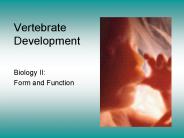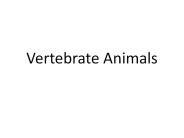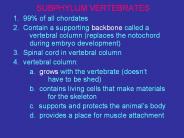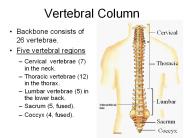Vertebral PowerPoint PPT Presentations
All Time
Recommended
1-56 of over 5,000
Biomechanical properties in sharks. Fish Skin. Mucous formed in epidermis cells ... Found in elasmobranchs (sharks & rays) 'teeth like', same composition ...
| PowerPoint PPT presentation | free to view
Vertebrates (subphylum vertebrata) Possess a backbone (aka vertebral column, spine) Vertebrae=Dorsal row of hollow skeletal elements (usually bone)
| PowerPoint PPT presentation | free to view
Vertebrates Stephanie Johns Definition of Vertebrates organisms with many cells heterotrophic endothermic or ectothermic Characteristics of Vertebrates Backbones ...
| PowerPoint PPT presentation | free to view
This is an introductory stack which will lead to an individual research project ... identification quiz at the end of the stack with at least 4 out of 5 questions ...
| PowerPoint PPT presentation | free to view
Vertebrates & Invertebrates Interactive Presentation designed by Mr. Phillips July 2004
| PowerPoint PPT presentation | free to download
Vertebrates Lungfishes Classes of Chordates Tetrapods Classes of Tetrapods Amphibians Urodela ( tailed ones ) Salamanders Anura ( tailless ones ) Frogs and ...
| PowerPoint PPT presentation | free to download
Vertebrates There are five groups of vertebrates. Vertebrates are animals with backbones. Birds Have feathers and wings Hatch from eggs Fish Live in water Most fish ...
| PowerPoint PPT presentation | free to download
Vertebrates Emily Reiss Josie Jacob-Dolan Tori Willbanks-Roos
| PowerPoint PPT presentation | free to view
Vertebrates Linnea Kirby, Michelle Duffy, and Adrienne Vergith-Hill
| PowerPoint PPT presentation | free to view
Vertebrates Phylum Chordata 4 basic characteristics: Notochord supporting rod dorsally located, below the nerve cord, replaced by vertebral column in most ...
| PowerPoint PPT presentation | free to download
Vertebrates 3.3.7.A Describe the similarities and differences that characterize diverse living things; describe how the structures of living things help them function ...
| PowerPoint PPT presentation | free to view
Title: Slide 1 Author: Jackson County School System Last modified by: JCBOE Created Date: 4/26/2005 11:40:19 PM Document presentation format: On-screen Show
| PowerPoint PPT presentation | free to view
Vertebrates Animals with backbones * * * * * * There are 5 vertebrate groups Amphibians (frogs and newts) Reptiles - (lizards and snakes) Fish Birds Mammals ...
| PowerPoint PPT presentation | free to view
You will be learning about two main classifications of animals: Vertebrates, invertebrates, and the ... and rasping teeth. There are two main types: Lampreys ...
| PowerPoint PPT presentation | free to view
Vertebrates. Animals with backbones. There are 5 vertebrate ... Dolphin - skeleton. Dinosaur fossil skeleton. X ray of rat. X-ray of lizard. X-ray - Frog ...
| PowerPoint PPT presentation | free to download
differ from other reptiles because their bodies are encased within a protective shell ... birds more than other living reptiles (care for young and four ...
| PowerPoint PPT presentation | free to view
Vertebrates Evolution and Diversity * * * Chordates Notochord: longitudinal, flexible rod located between the digestive and the nerve cord Dorsal, hollow nerve cord ...
| PowerPoint PPT presentation | free to download
Gnathostomes Vertebrates with jaws. Derived Characters Jaws Duplication of Hox genes: Gave rise to larger brains, enhancing smell and vision.
| PowerPoint PPT presentation | free to download
Kinds of animals with backbone. Mammal, Bird, Fish, Amphibians, and Reptiles are examples of Vertebrates Animals. Science for Primary
| PowerPoint PPT presentation | free to download
... some have a 4 chambered heart Vertebrates Vertebrata Reptiles Vertebrates Vertebrata Aves *endothermic* covered in feathers lay eggs (hard ...
| PowerPoint PPT presentation | free to download
Vertebrate Pests Rats, House Mice, Pocket Gophers, Ground Squirrels, Tree Squirrels, Moles, Rabbits and Bunnies, Deer, Pigeons, European Starlings, Etc.
| PowerPoint PPT presentation | free to view
Human embryo (5 weeks) Notochord attachment site for muscles ... Platypus. P. Chordata. Mammalia. Monotremes. Echidna. P. Chordata. Mammalia. Marsupials ...
| PowerPoint PPT presentation | free to view
Vertebrate Tissues OMHS Human Anatomy and Physiology Class
| PowerPoint PPT presentation | free to view
Blood that circulates through blood vessels or lungs for breathing ... Question 1: Many species of amphibians on Earth are mysteriously vanishing. true or false ...
| PowerPoint PPT presentation | free to view
Vertebrate Adaptations Evolution of the Skeletal System General Trends in the Skeleton Simplification through bone loss, bone fusion, and ossification.
| PowerPoint PPT presentation | free to download
Biology II: Form and Function The six stages of vertebrate development Fertilization Cleavage Gastrulation Neurulation Neural crest formation Organogenesis Stage of ...
| PowerPoint PPT presentation | free to download
Non-Vertebrates Period 5 Umer Khan James Trimble
| PowerPoint PPT presentation | free to view
Sharks. Skates. Rays. Basking Shark / Whale Shark. Angel Shark / Hammerhead. Class Osteichthyes ... The largest sea fish is the rare plankton-feeding whale shark. ...
| PowerPoint PPT presentation | free to view
II) Fish. A) Agnatha: jawless fish. 1) suction mouth. 2) notochord remains. a)lack bony skeleton cartilage. 3) ex. lamprey and hagfish *
| PowerPoint PPT presentation | free to download
The Vertebrates Vertebrate Characteristics Vertebrae (backbone) Notochord (flexible dorsal rod) Nerve cord (hollow) with brain Three layers of cells as an embryo ...
| PowerPoint PPT presentation | free to view
Chapter 34 Vertebrates Class Agnatha Class Agnatha Class Chondrichthyes Chondrichthyes Cartilage skeleton 750 species Oil in liver for buoyancy May sink if they stop ...
| PowerPoint PPT presentation | free to view
Comparing Vertebrates The Chordates A chordate is an animal that has, for at least some stage of its life, a dorsal, hollow nerve cord; a notochord; pharyngeal ...
| PowerPoint PPT presentation | free to view
Nest French Frigate Shoals. 1,000 females. Family Cheloniidae. Chelonia agassizii ... Birds. Primarily defined by adaptations for flight. Lack urinary bladder ...
| PowerPoint PPT presentation | free to view
Vertebrate Diversity Chapter 34 Senses: vision, but no color; olfaction; electrical senses * Chordate Phylogeny Phylum Chordata Bilaterian deuterostomes Derived ...
| PowerPoint PPT presentation | free to view
SUBPHYLUM VERTEBRATES 1. 99% of all chordates 2. Contain a supporting backbone called a vertebral column (replaces the notochord during embryo development)
| PowerPoint PPT presentation | free to download
Vertebrates: Introduction A: Classification all belong to Phylum Chordata B: Shared Characteristics Have a backbone encases/protects the dorsal nerve cord (spine ...
| PowerPoint PPT presentation | free to download
Strong Chests muscles Only group adapted to life in the air. Body covered with feathers Modified scales Made of protein and develop in pit in the birds skin.
| PowerPoint PPT presentation | free to view
Vertebrate Tissues Tissues Cells + extracellular material have a particular function Four main tissue types: Epithelial Tissue Connective Tissue Muscular Tissue
| PowerPoint PPT presentation | free to view
Vertebrate Diversity Chapter 34 Senses: vision, but no color; olfaction; electrical senses * Chordate Phylogeny Phylum Chordata Bilaterian deuterostomes Derived ...
| PowerPoint PPT presentation | free to view
Did it all begin with locomotor needs? ... Swingers and jumpers. Thoracic and lumbar proportions. Human vertebral column and other primates ...
| PowerPoint PPT presentation | free to view
Sharks, rays, skates. Actinopterygii. Common fish. Lobe ... Nurse young with milk from mammary glands, provide parental care. Large brain. 4 chambered heart ...
| PowerPoint PPT presentation | free to view
... - tabes dorsalis - Les es medulares - Compress o por tumores Neuropsicoend crinoimunologia Media es mente-corpo Transtornos puerperais e pr ...
| PowerPoint PPT presentation | free to view
Aquatic Vertebrates with paired fins, scales, & gills. ... absorb oxygen from water, water and carbon dioxide pumped out through operculum ...
| PowerPoint PPT presentation | free to view
Hernias Discales Hernias Discales Hernias Discales Signos Cl nicos Lumbalgia Contractura Ciatalgia Signo de LASEGUE Testigo de la compresi n de una rama nerviosa ...
| PowerPoint PPT presentation | free to download
Vertebrate Animals Highlight what is BOLD/UNDERLINED DOMAIN- Eukarya KINGDOM- Animalia PHYLUM- Chordata SUBPHYLUM- Vertebrata CLASS- 7 different ORDERS- 10 Placental ...
| PowerPoint PPT presentation | free to download
Vertebrates are Animals with a backbone Chordate What are they- An animal that has, for al least some stage of its life, a dorsal hollow nerve cord; a notochord ...
| PowerPoint PPT presentation | free to view
None gastrovascular cavity complete digestive system. Body cavities ... Larval urochordate exhibiting paedogenesis* cephalochordate * Early sexual maturity. ...
| PowerPoint PPT presentation | free to download
Name means cartilaginous fish ... Class Actinistia lobe finned fish. Coelocanth. Class Dipnoi lungfish ... Grasping fingers for tree life. Binocular vision ...
| PowerPoint PPT presentation | free to view
Cartilage skeleton, parasitic fish. Class Chondrichthyes - sharks. Cartilage skeletons. Class Osteichthyes - bony fish. Skeletons made of bone ...
| PowerPoint PPT presentation | free to view
Vertebral Column Backbone consists of 26 vertebrae. Five vertebral regions Cervical vertebrae (7) in the neck. Thoracic vertebrae (12) in the thorax.
| PowerPoint PPT presentation | free to download
Vertebrate Development Chapter 51 Material to be covered (for Tri-C) Describe the events of each of the three stages of fertilization in an advanced vertebrate.
| PowerPoint PPT presentation | free to download
Trends in Animal Evolution Symmetry ... deuterostome Digestive system None gastrovascular cavity complete digestive system Body cavities acoelomate pseudocoelomate ...
| PowerPoint PPT presentation | free to download
Vertebrate Characteristics Kingdom Animalia; Phylum Chordata; Subphylum Vertebrata Chordata Characteristics Dorsal hollow nerve cord Notochord ( back cord ...
| PowerPoint PPT presentation | free to view
History of Vertebrates Ch. 20
| PowerPoint PPT presentation | free to view
Vertebrate, invertebrate Animals have many cells and those cells form tissues and organs Animals consume other organisms to get the nutrients and energy they need ...
| PowerPoint PPT presentation | free to view
























































